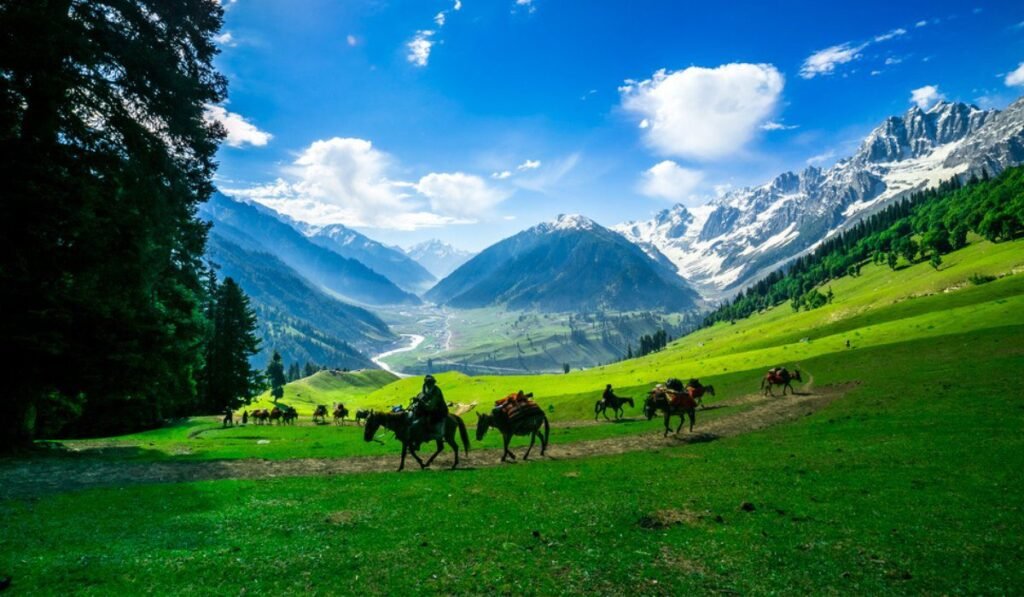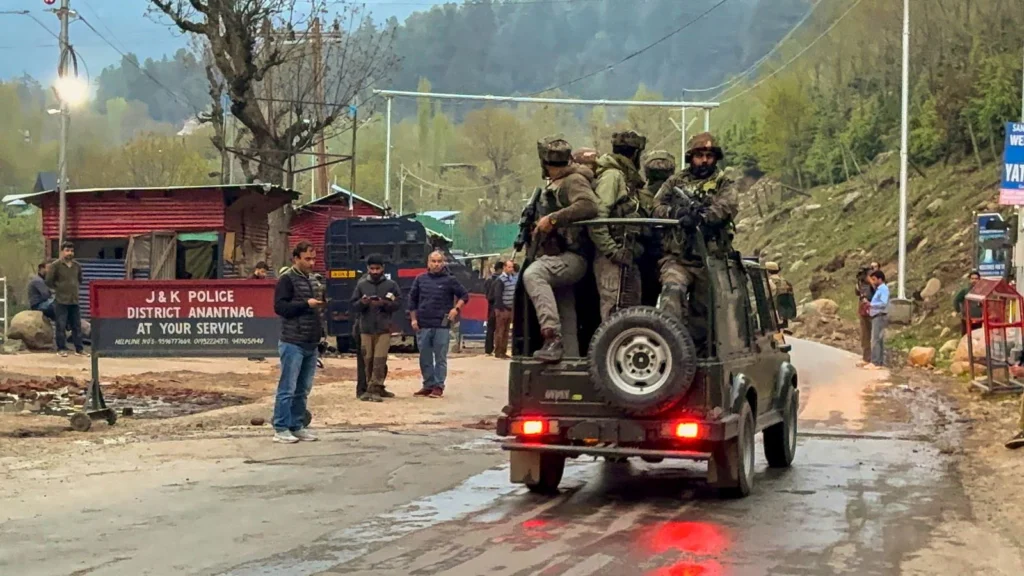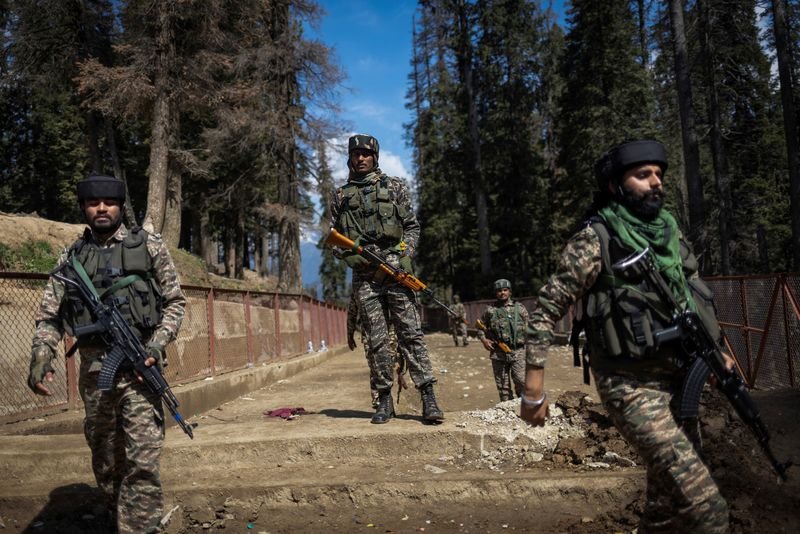
An image of Pahalgam, Kashmir
Pahalgam, an emblem of beauty:
Pahalgam in Jammu and Kashmir is an attractive tourist spot known as heaven on earth for tourists. It is also referred to as mini-Switzerland. Tourists swarm in like bees at Pahalgam to spend their holidays with their loved ones. But it is a matter of dejection that this beauty of the world have been sbject to a devastating terrorist attack on 22 April, 2025.
It is heard that the local horse riders attempted to save the tourists, but one of them succumbed to death also in that incident. This heinous attack killed 26 people who went there to enjoy the beauty of nature. Now, think about the common people of that region what is going through their lives.
Tourism is the only major source of income of Kashmiri people. The common people of Kashmir are very friendly and amiable to the tourists. They were somehow leading their lives peacefully but, this inhuman incident left their lives at stake.
Shocking Pahalgam attack stunned the world:

I am talking about the VERY GRUESOME attack that took place in the Baisaran Valley area of Pahalgam, Anantnag district. I have heard that two or three gunmen opened fire at the tourists visiting that place. The heinous attack claimed the lives of 26 individuals, mostly tourists, and it is also reported that 17 individuals have been injured.
Through news and media, I have learned that a very little-known group named “Kashmir Resistance Front (KRF)” has claimed responsibility for the attack in a social media message. It expressed discontent that more than 85,000 OUTSIDERS had been settled in the region, spurring a “ demographic change”.
“Consequently, violence will be directed toward those attempting to settle illegally,” it said.
Reuters could not independently verify the source of the message.
The regional government of Jammu and Kashmir, where Pahalgam is located, told its legislature this month that nearly 84,000 non-locals within India had been given domicile (the country that a person treats as their permanent home, or lives in and has a substantial connection with) rights in the territory in the last two years.
However, this is not the first time that Pahalgam has been attacked by terrorists. Such a terror incident also happened on 1 and 2 August 2000, named the Amarnath Pilgrimage Attack.
It was the massacre of between 89 and 105 people, with 62 others injured in at least five different coordinated attacks by terrorists in Anantnag district and Doda district of Indian administered Kashmir.
In that massacre on 2 August 2000, 32 people were killed at
the Nunwan base camp in Pahalgam.
According to Wikipedia, the dead included 21 Hindu pilgrims, 7 local Muslimshopkeepers, and 3 security officers. 7 other people were also injured.
It is also important to mention another major terrorist incident that occurred on February 14, 2019, in the Pulwama district of Jammu and Kashmir, India. In that incident, 40 Central Reserve Police Force (CRPF) jawans were killed.
Now, many questions are arising:
a) Where was security in such a sensitive region where several terror attacks had taken place before?
b)Why has security failed time and again?
c)Why were civilians targeted?
d)Were the victims only Hindu?
e)How did the terrorists penetrate such high security?
We didn’t find any clear and concrete answers to these terrorist attacks in the past. So, it is very clear that Indian intelligence has failed again.
Let’s have a look at some facts associated with such incidents.
Kashmir, an apple of discord between India and Pakistan:

The primary reasons for conflict between India and Pakistan are a long-standing dispute over the Kashmir region, cross-border terrorism, and water resource management. Historical legacies of partition, differing national identities, and power struggles also contribute to the tensions.
India’s internal conflict regarding Muslims and other communities:
India’s internal conflicts involving Muslims and other religious groups stem from a complex history of politics, colonialism, identity, and socio-economic differences. Have a look at the backgrounds of the main key elements:
1. Historical Background
Partition of India in 1947: When British India was divided into India and Pakistan, mass violence broke out between Hindus, Muslims, and Sikhs. This laid the foundation of future tensions.
Legacy of Mughal Rule & British Divide-and-Rule: Historical narratives around Muslim rulers and colonial policies sowed mistrust between communities.
2. Political and Legal Issues
Rise of Hindu Nationalism: The ruling BJP and organizations like RSS promote a Hindu-centric ideology (Hindutva), which may be seen as marginalizing Muslims.
Citizenship Amendment Act (CAA) & NRC: Critics argue these laws discriminate against Muslims.
3. Social and Economic Marginalization
- Sachar Committee Report (2006) found that Muslims lag behind in education, jobs, and public representation.
- Housing and Employment Discrimination: Muslims often face bias in renting homes or getting jobs in certain sectors.
4. Communal Violence:
India has witnessed several major incidents of religious violence, often involving Muslims and Hindus, such as:
Nellie Massacre (Assam 1983): Over 2000 Muslims killed.
Babri Masjid Demolition & Subsequent Riots (1992):
The BJP and affiliated organizations like the VHP and RSS were involved in the campaign to demolish the Babri Masjid in Ayodhya. This led to widespread Hindu-Muslim riots across India.
Gujarat Riots (2002), BJP-led state government:
After a train carrying Hindu pilgrims caught fire in Godhra, large scale riots broke out in Gujarat. The state government, led by then chief- Minister Narendra Modi, was accused by human rights groups of not doing enough to stop the violence, and even of encouraging though he was cleared by the Supreme Court-appointed SIT later.
Muzaffarnagar Riots (2013):
Tensions in western Uttar Pradesh led to communal clashes. Both the Samajwadi Party (which was in power in UP at the time) and BJP Leaders were accused of making inflammatory speeches or failing to act in
time.
Delhi Riots (2020):
Sparked during protests against the Citizenship Amendment Act (CAA). There wereaccusations against BJP leaders for inciting violence, but the situation was also complexand politically charged.
Current Climate:
Media & Social Media:
Often polarize issues, fuelling tensions.
Mob Lynching:
Several Muslims have been lynched over allegations of cow slaughter or beef possession.
Religious Polarization in Elections: Religion is frequently used as a tool to mobilize voters, causing further division.
Terrorism:

We human beings the children of Adam and Eve living on earth as brothers and sisters.
We may have different color,taste,choice,culture,ethnicity, and religion. We will have to practice patience and tolerance, and should respect each other as human beings, and should not hurt each other, abuse each other let alone killing each other which is considered as a heinous crime in any religion. Any sort of terror attack or activity is considered as crime against humanity.
In such a sensitive situation, political leaders should also react responsibly. They should refrain from uttering any sort of provocative words and should not play the blame game. Their one mistake can bring about havoc in many countries.
We have founded several inter-national institutions to solve such problems. But, unfortunatley, when we face problems with each other, we don’t take initiatives to resove these issues using those forums and institutions.
- Where is the interest of these political and international leaders?
- Why do they fail to resolve these iusses of the world?
- Why do they fail to build a peaceful world?
We have become disgusted to see the world leaders doing same thing again and again. They gather on a particular place organized by our so called international institutions give their lectures on podium, and leave the place without solving the problems of the world.
They are just concered about the financial agreements, deals, and devolopment of their respective countries. Ok fine, economic solution is also needed. But where are other solutions.
Don’t they see the human sufferings? When there is question of business, sharing technology, art and culture, arms and ammunitions, we proudly advocate that our world is a global village.
Okay I do comply, but where is the solution of human problems,sufferings and sorrows, poverty and unemploymet, problems of health and sanitization.
- Where is the solution of conflict between India and Pakistan regarding Kashmir?
- Where is the solution of war between Ukraine and Russia?
- Where is the solution of war between Isreal and Palestine ?
- Where is the Rohinga Solution?
There is no solution. Rather, conflict among countries are increasing over time.
If we want to uproot the whereabouts of terrorism, we will have to solve our internal disputes and conflicts first . Since our world is a global village, here it is important to realize the vastness of the term global village.
If your neighbor has any promblem, you overlook it right. Oh, you don’t. Similarly, if any neighbouring country has any problem, other neighbours of that country shouldn’t overlook it or ingnore it.
So, first resolve the internal disputes and conflicts, and then deal with the iusses of your neighbours. Our international forums and institutions can play a pivotal role to conclude these problems. But, the thing that we need most is our positive intent. If we have positive objective ot resolve these disputes and conflicts, then we can make our world a peaceful abode.
Last but not the least, terrorism of any kind or form has no space in the world. The leaders of the world should come forward on a common platform to send this word terrorism in a museum. Nobody, should tag this term to any particular group or religion, and patiently deal with the situation. If the leaders of the world determine, they are quite able to solve this problem of the world, and ensure a peaceful co-existence of all the countries. Let’s make a peaceful world together, where there will be no conflict and clash, where there will be no terrorism and war.

.jpg)

